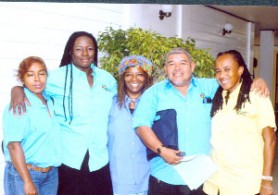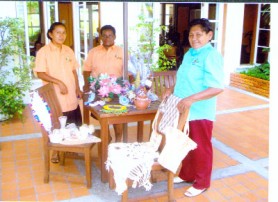Guyana’s talented community of art and craft producers appear, finally, to be seeking in earnest to lift themselves out of the condition of underachievement that has characterized what is widely believed to be a potentially lucrative industry. They want, they say, to take what they believe is their rightful place in both the Guyana economy and in the local cultural tapestry.
A cursory glance at the handful of creations on display at the Cara Lodge earlier this week attests to the creative traditions of the respective communities across the country, traditions which, in many cases, have remained mostly confined to their indigenous settings, constrained by circumstances that have proven difficult to overcome. While the skills that have created these works of art out of an array of media are readily apparent, how to fuse their individual talents into a viable economic sector is a ‘trick’ which, for years, has eluded them.

If the recent three-day forum staged by the Guyana Art and Craft Producers Association is anything to go by, it appears that the local producers are beginning to see the light, to recognize that their individual talents cannot, by themselves, fashion a holistic and viable art and craft industry.
The forum, sponsored by the Ministry of Tourism and Commerce afforded affiliates of the 175-member Association the opportunity to put heads together, to seek to create a strategic plan, a vision for themselves and for the community of art and craft producers that transcends the cottage industry image in which it has long been clothed. The problem, in the main, is their lack of capacity; not creative capacity; much of the best that they have to offer derives from skills created in the humblest of homes, on living room floors and dinner tables. It is their lack of capacity to turn ‘cottage’ into commerce that is their primary deficiency.
Patricia Helwig, the Association’s Public Relations Officer, believes that this week’s forum may well be the most significant initiative that the organization has undertaken since its formation in March 2008. The three-year strategic plan embraces what Helwig believes are the “building blocks,” the foundation upon which the Association will eventually come to rest. The concerns of the strategic plan are with finances, securing material for producer members, acquiring premises that can serve both as a secretariat and as a display centre and point of sale and securing export markets. These, quite simply, are among the critical challenges that continue to bedevil local art and craft producers.

Helwig makes no secret of the fact that financing has been a major obstacle to progress by the mostly working class women, many of whom produce art and craft for a living. It is, in many instances, a painstaking existence, subsisting from one small handful of creations to another and sometimes, for want of money or material, coming to a shuddering halt.
To help shape their strategic plan the Association gathered members from across the country to talk about the future. Helwig says that a realistic strategic plan for the Association must, of necessity, embrace the concerns of the various communities, the various cultures and the various creative people who produce art and craft locally, It would make no sense, she says, to leave anyone on the periphery.
The officials of government – the Minister of Commerce, the President of the Guyana Manufacturing and Services Association and the Executive Director of Go-Invest were there this week to lend a measure of officialdom to the proceedings, but it was the concerns and considerations of the members, women mostly, that were the essence of the agenda. They concede that government needs to play a role in helping to develop an industry which, in its present state, supports an estimated 2,000 people. In the longer term, however, the aim of these artists and craftspeople is to consolidate an independent industry capable of standing on its own.
Local art and craft still languishes on the periphery of the commercial mainstream, attracting rave reviews for its ‘niceness’ after which its professed beauty is quietly returned to the closet of relative obscurity.
The creators, make no secret of the fact that they are tired of having their work confined to mere sideshows, often as a kind of afterthought, serving as little more than decorative appendages to grander stages, or else, exposed occasionally to some larger exposition at which admiring visitors really do no more than provide patronage by purchasing inexpensive trinkets.
One woman, who insisted that she remain anonymous, still frets over what she describes as the “huge letdown” which she said that Cricket World Cup of 2007 turned out to be for local craft producers. ”Everything was promised and in the end we got nothing,” she said.
Helwig is more optimistic. Her optimism derives from what she says are some of advances which members of the Association are already making. “Some of them already have markets overseas,” she says.
To help them get their heads around their financing problems they invited the Head of the DFLSA, a microfinancing subsidiary of a Trinidad and Tobago-based company. They need an even larger financial breakthrough, the blessings of the banks for the sector as a whole and the removal of the weighty conditionalities that render commercial bank loans difficult.
Helwig says that part of the objective of the kind of exposure that the forum afforded is to ‘transform members’ thinking, to help them to think of what they do as economic ventures. That, perhaps above all else, is a process. If the art and craft industry is to move closer to the centre of the commercial mainstream the producers will have to develop or acquire skills that go well beyond their present talents.
There is, for example, the issue of markets and marketing, formidable hurdles at which many local art and craft enterprises have stumbled and fallen. GuyExpo or occasional exposure to a regional or international trade show is hardly a substitute for sustained, multi-media (and, admittedly, costly) product promotion, built around a refined understanding of global consumer trends, niche marketing, and, from a regional standpoint, the patterns of the tourist industry. Part of the problem herein says Irene Bacchus, one of Linden’s best-known producers of wooden artistic creations is that producers must market their own goods “and what we have long discovered is that marketing is a separate skill which many … of us simply do not have.” The challenge of marketing applies tenfold in the country’s Amerindian communities where the lack of any real marketing skills is compounded by the distance from urban markets. Part of what the forum seeks to do is to develop a marketing capacity from which the entire community of art and craft producers can benefit. Richard Winter says he has seen it all before as a member of the Brazil Art and Craft Association where members are expected to look out for the marketing of each other’s work.
Tracy Douglas, a native of New York and a creator of tie-dyed material who migrated here recently with her Guyanese-born husband brings to the Association a fresh perspective on the challenges that face small businesses “even in the United States.” She says that her own efforts to market her tie-dyed creations in North Carolina met with far from glowing success. “The feeling there was that you could go into a store and buy a kit and do it yourself. Here in Guyana where she runs her own tie-dye production operation at a small establishment on the Soesdyke/Linden Highway, Tracy appears keen both to learn from the separate experiences of her local counterparts and to share her experiences on what she believes are some of the common challenges confronting artists and craftspeople everywhere.
Patricia says that the individual strides that are being made by members of the Association have provided a kind of collective incentive for the group. What local craft producers need, she says, is much more recognition and support of the local corporate community. She says that while there are occasional opportunities to exhibit and to market through larger establishments, there must be more such opportunities and with those opportunities a recognition of both the cultural relevance and commercial viability of the sector.
Some of these opportunities may perhaps come through people like Ingrid Goodman an energetic Guyanese woman whose Arts of The Caribbean establishment in Grenada is seeking to support the promotion of Guyanese art and craft in the region. She travelled to Guyana recently, she says, to meet directly with buyers, to “cut out” those middle men who very often get the lion’s share of profits that ought correctly to be returned to the producers as a means of acknowledging the value of their talents. Armed with an impressive knowledge of the regional tourism culture Ingrid says that Guyana produces the most marketable art and craft in the region and that it compares favourably with her imports from East Africa.
If Ingrid’s analysis of market behaviour in the region is correct, however, what may well be militating against the ability of Guyana’s art and craft industry to take its rightful place in the Caribbean market is a prevailing intra regional insularity that flies in the face of the single market objective to which the Caribbean Community says it aspires. Apparently, the high quality of art and craft produced here has not been enough to win acceptance in some other regional markets where, it seems, they are seen as a threat to the respective craft industries. Still, Ingrid, who wants Guyanese art and craft to be branded, persists. This year and despite the uncertainty of the economic and financial climate and the consequential uncertainty of the tourist industry, she is, for the first time, hoping to ship a container of local craft to Grenada.
Patricia is quietly confident that this latest initiative will work. The members of the Association, she says, have become wary of talk shops and appear determined to use this opportunity to take the sector forward.




